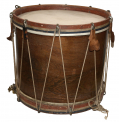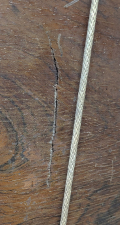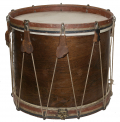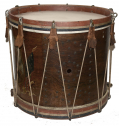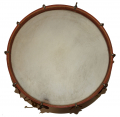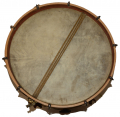site search
online catalog
EISENBRANDT EXHIBITION GRADE PAINTED DRUM WITH ZOUAVE BATTLE SCENE
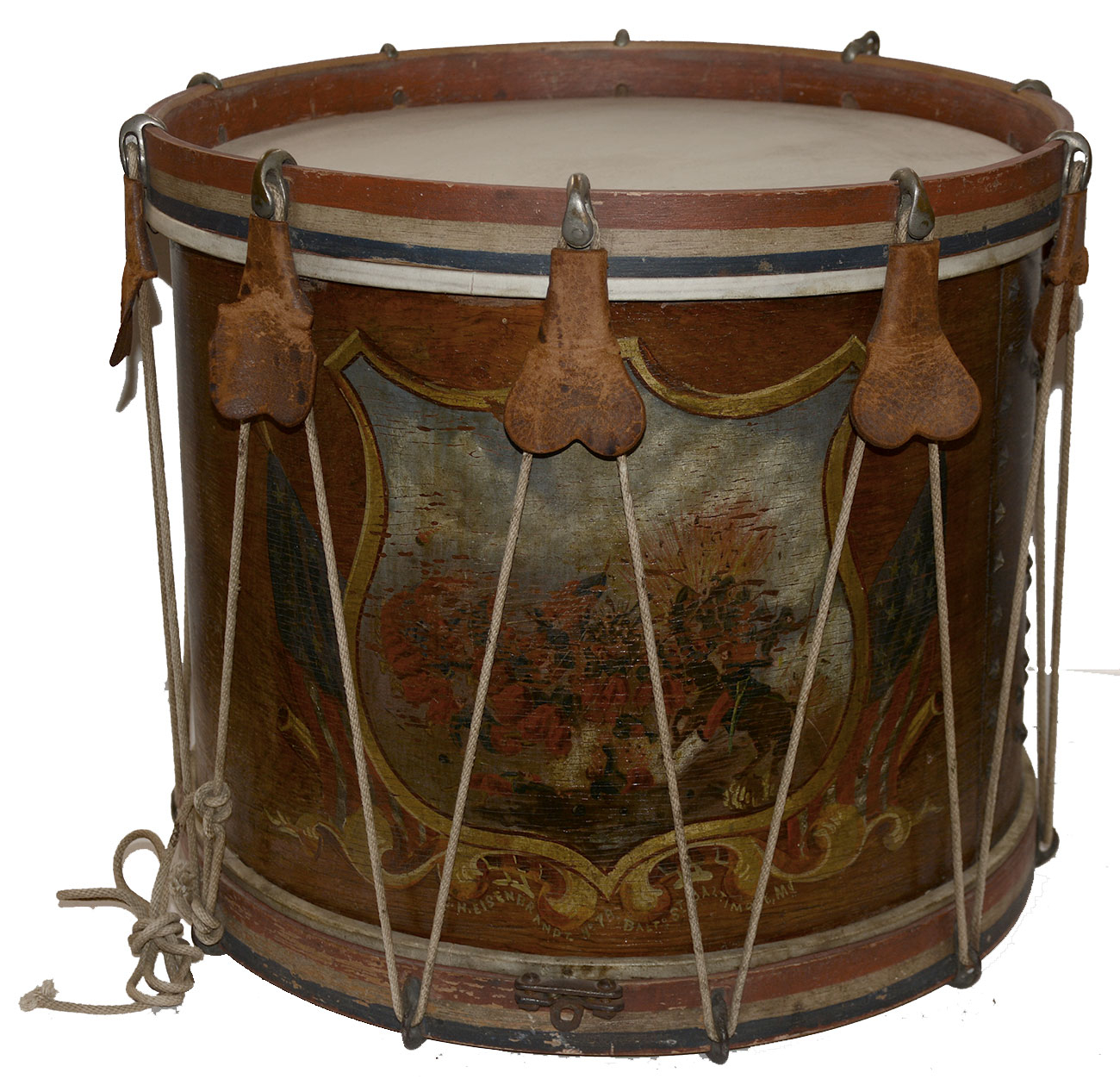
$5,500.00
Quantity Available: 1
Item Code: 766-2003
Shipping: Determined by Method & Location of buyer
To Order:
Call 717-334-0347,
Fax 717-334-5016, or E-mail
Measuring 15-1/2 by 17 inches, this rope-tension side drum is fitted with red, white and blue rims, has the overlap secured by more than fifty star-shaped brass tacks in two vertical lines with horizontal diamonds above and below a circle around the vent hole, and bears a large painted battle-scene featuring a charge by zouaves on the face, with the painted Baltimore maker’s name and address bordering the foliate supporting decoration of the panel rather than concealed on an interior label. It has very much the look of a piece suitable for a store window or on display at a venue like the Maryland Institute Fair of October 1862 in Baltimore, where, “C. H. Eisenbrandt has a number of drums,” according to a notice in the Baltimore Sun, though the impressive decoration may have been intended for a particular unit. A nearly identical Eisenbrandt drum from the Flayderman collection is pictured and discussed as Plate 73 in Caba’s “United States Military Drums 1845-1865, A Pictorial Survey,” deemed at that time the only known authentic battle scene on a Civil War era drum with the painting attributed to an unknown local artist employed on other Baltimore drums as well. The one offered here differs only slightly in some painted details, the use of star-shaped tacks, and two-piece rather than one-piece hooks on the upper rim that may be Eisenbrandt innovations or later replacements.
The battle scene shows wear and darkening but clearly pictures a double-ranked line of red-trousered zouaves charging forward from the left, encouraged by a mounted zouave officer in the right, moving to join an advanced line carrying a U.S. flag who are storming some enemy works with what looks like a hand-to-hand struggle at upper right that shows some clubbed muskets being wielded, with the critical point highlighted by a fiery explosion. The scene is painted within a shield-shaped central panel with gold border forming an upper scalloped edge and curving sides meeting at a shallow point at bottom center. The panel is flanked by a U.S. flag and cannon barrel and rests on a pair of long foliate flourishes with the maker’s name painted along the lower edge: “C.H. EISENBRANDT No. 78 BALTo St. BALTIMORE Md.”
Eisenbrandt was a German immigrant who reached the U.S. in 1811, living first in Philadelphia, returning to Germany for a few years, and then moving again to the U.S. and settling in Baltimore in 1819. His name seems to have been Heinrich Christian Eisenbrandt, but shows up more often, including in his own advertisements, as “C. H. Eisenbrandt.” He made or dealt in all sorts of musical instruments including fifes, drums, clarinets, oboes, sax horns, trumpets, bugles, guitars and “grand and square piano fortes,” and exhibited at various fairs, boasting a Prize Medal at the World’s Fair and Gold Medal at the Maryland Institute in 1850 and 1851. He died in Baltimore in March 1860, but the business was continued by a son, H.W.R. Eisenbrandt, who seems to have kept the same business name until about 1866/67, when it shows up as “H.R. Eisenbrandt,” giving an upper date for the drum. The zouave craze does not really take hold in the U.S. until 1860, resulting from Ellsworth’s tour, so we would not date it earlier than that and the battle scene with the U.S. flag clearly points to a Civil War engagement.
C.H. Eisenbrandt was something of an inventor as well, reportedly earning praise for technical innovations as figuring out how to bore fifes in one step and improving valves in saxhorns, receiving two patents involving brass instruments. We note that rather than feeding the rope through holes in the rims, this drum uses hooks to make it easier to remove and replace the heads, something well-evidenced by commercial and privately purchased military drums of the period and in Civil War photographs, and showing up on the Flayderman drum as well. Where the Flayderman drum uses them on both top and bottom, from what we can see in the photos, this one uses them on the bottom, but on the top rim uses plated two-piece hooks. These might be an innovation by Eisenbrandt, but given the exclusive use of the one-piece versions on the nearly identical Flayderman drum, these may well be later replacements during its useful life. The bottom head and snare appear to have good age. The top, batter, head was clearly replaced, not at all uncommon in the period, and the rope is modern, though the nine remaining leather tighteners have good age, with minor losses, and were likely from the original rope. [sr][ph:L]
Extra shipping required.
~~~~~~~~~~~~~~~~~~~~~~~~~~~~~~~~~~~
THIS ITEM, AS WITH ALL OTHER ITEMS AVAILABLE ON OUR WEB SITE,
MAY BE PURCHASED THROUGH OUR LAYAWAY PROGRAM.
CLICK HERE FOR OUR POLICIES AND TERMS.
THANK YOU!
Inquire About EISENBRANDT EXHIBITION GRADE PAINTED DRUM WITH ZOUAVE BATTLE SCENE
For inquiries, please email us at [email protected]
Most Popular
Historical Firearms Stolen From The National Civil War Museum In Harrisburg, Pa »
Theft From Gravesite Of Gen. John Reynolds »
Selection Of Unframed Prints By Don Troiani »
Fine Condition Brass Infantry Bugle Insignia »
British Imported, Confederate Used Bayonet »
Scarce New Model 1865 Sharps Still In Percussion Near Factory New »
featured item
VERY RARE CONFEDERATE “ROPE BORDER” BELT PLATE
Dug condition stamped brass oval “rope border” belt plate. Unlike their US counterparts, these were not lead filled. These are not commonly found and can most often be traced back to the contractor Magee and George of New Orleans. The firm of… (1202-260). Learn More »
site search
Upcoming Events
May 16 - 18: N-SSA Spring Nationals, Fort Shenandoah, Winchester, VA Learn More »







